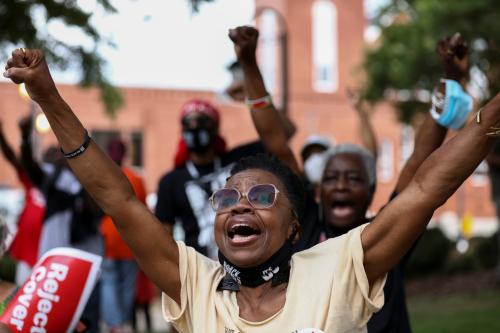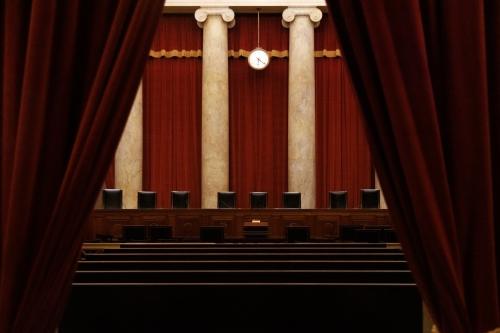From the beginning of his campaign in 2007, Barack Obama offered a centre-left programme of expanded public power in areas such as healthcare, energy and the environment, education and infrastructure. In the months immediately preceding the election, however, mounting economic pressures yielded an abrupt economic downturn. Mr. Obama thus assumed the presidency with two agendas — the agenda on which he campaigned, and the agenda that events had forced upon him. Many commentators believed that he would be forced, or at least well advised, to defer the former until he had implemented the latter. The new president disagreed, arguing that short-term economic recovery and long-term economic renewal were inextricably linked. He has wagered his presidency on the proposition that the US budget and political system can simultaneously absorb an economic stimulus, bail-outs of financial institutions, the housing sector and the automobile industry, comprehensive regulatory reform… and a social-democratic programme not seen since the days of Lyndon Johnson, perhaps even Franklin D. Roosevelt (FDR).
“Uncharted waters” may be the cliché du jour, but it captures the widespread sense that America is trying to navigate without maps. The governing assumptions of the past three decades have been discredited. Markets are not always self-correcting; financial innovation does not always enhance, or regulation always impede, efficiency and growth. But diminished faith in markets does not necessarily mean enhanced faith in government. Shortly before Obama took the oath of office, Americans’ trust in their national institutions reached the lowest level ever recorded. A key question is whether the public will support, and Congress will enact, a programme that relies so heavily on the capacity of the national government to serve as an effective instrument of national purpose This is in part a question of fiscal capacity. Estimates of budget deficits averaging nearly $1 trillion each year for the next decade have sent shock waves around the world. But success depends as well on Obama’s ability to manage his agenda, as it does for every president determined to make more than incremental change. An experienced public official offered a blunt assessment of one new chief executive: “[He] has proposed a huge restructuring of government, and people are actually taking him seriously. The man… turns out to be downright radical.” This was Ronald Reagan, who pushed through changes in spending and taxes that redefined economic policy for a generation. After a week in office, another newly minted president mused in his diary: “Everybody has warned me not to take on too many projects so early in the administration, but it’s almost impossible for me to delay something that I see needs to be done.” That president was Jimmy Carter, whose flood of proposals soon had Congress bogged down in near-gridlock. By the end of his first year, America was beginning to wonder whether Carter was up to the job.
Will Obama turn out to be as successful in pushing his agenda as Reagan, or as unsuccessful as Carter? The core issue is the clarity and self-discipline needed to maintain control of the agenda. Consider the judgment of Erwin C. Hargrove, a respected scholar of the presidency, rendered after Reagan’s first 100 days: “Reagan has demonstrated, in a way that Jimmy Carter never did, that he understands how to be president. He knows that a president can deal with only a relatively small number of issues at a time.” Hargrove might have added that the same is true of Congress, a fact every president must keep firmly in mind.
Supporters of the current administration’s approach might retort that it’s 1933, not 1981, and the relevant model is FDR, not Reagan. The US is heading toward its grimmest year in generations, and so we need bold action on a broad front. But consider how FDR governed. Although he assumed office with nearly unchecked power — in 1933, the Democrats held majorities of 313 in the House and 59 in the Senate — he was careful to focus his early domestic policy almost exclusively on the economic emergency. Believing that the banking crisis was at the heart of the crisis of confidence, he declared a banking holiday within two days of taking office. Four days later, on March 9, he introduced the Emergency Banking Act, which Congress enacted the same day.
By contrast, Roosevelt delayed most of the structural reforms that did not bear directly on the economic emergency. While he was more sensitive than previous presidents to the links between seemingly disparate issues, these interconnections in his view did not warrant trying to move on all fronts at once. The people and Congress had to be brought along with an agenda they could understand. FDR never believed that his capacity to legislate would wane after his first year in office. On the contrary, he used early momentum to build popular support, yielding further congressional gains in 1934 and a massive landslide in 1936.
There is another objection to the “2009 = 1933” thesis: current circumstances in the US do not approach the gravity of the situation FDR faced when he took office. To date, GDP has fallen at an annual rate of about 6% from its 2008 peak; by 1933, GDP had fallen nearly 40% from four years earlier. Unemployment is now 8.1%, up from 4.9% a year ago; by early 1933, unemployment was 25%, including 37% outside the agricultural sector. Today the banking system is in deep trouble, but at the start of the New Deal it was much worse. As FDR took office on March 4, 1933, all 12 Federal Reserve banks were closed, and banks in 37 states had either limited withdrawals or shut their doors. The American people are not prepared to give the president and his party the degree of deference that Roosevelt and the Democratic Congress enjoyed at the start of the New Deal — all the more reason for Obama to distinguish between short- and long-term measures at least as carefully as FDR did.
The budget deliberations in the House and Senate will define the limits of presidential aspirations, at least for this year. Developments thus far suggest that the president will not be able to enact cap-and-trade legislation (the linchpin of his climate-change agenda) or to make permanent his redistributive tax cuts. On the other hand, the congressional budget initiatives will not prevent fundamental health- insurance reform from moving forward. In fact, there is far more consensus about the contours of acceptable reform today than there was when Bill Clinton tried and failed 16 years ago. Paying for reform may well be the most formidable remaining obstacle: helping poor- and moderate-income families to purchase health insurance will cost an estimated $120 billion annually, and the congressional budget committees have refused to endorse the tax increases the Obama administration proposed to help pay for it. Given the dire fiscal outlook for the next decade, with uncertainty rising that foreign governments will be willing to fund US deficits, it seems unlikely that Congress will adopt comprehensive health reform without an equally comprehensive funding strategy.
One thing is clear: getting a historically anti-statist and tax-averse people to go along with his plans will require all of President Obama’s considerable persuasive powers.



Commentary
Op-edThe Future of President Obama’s Agenda
April 19, 2009